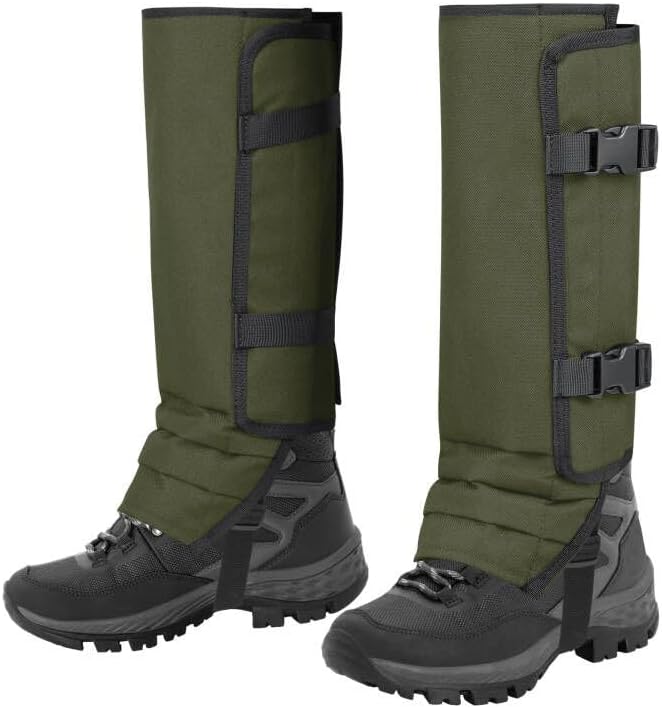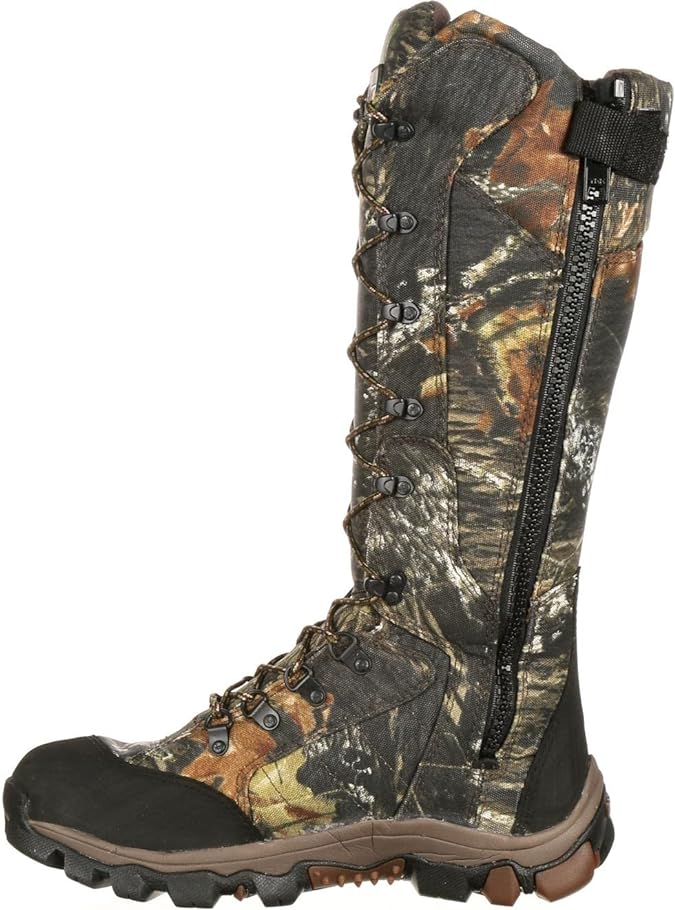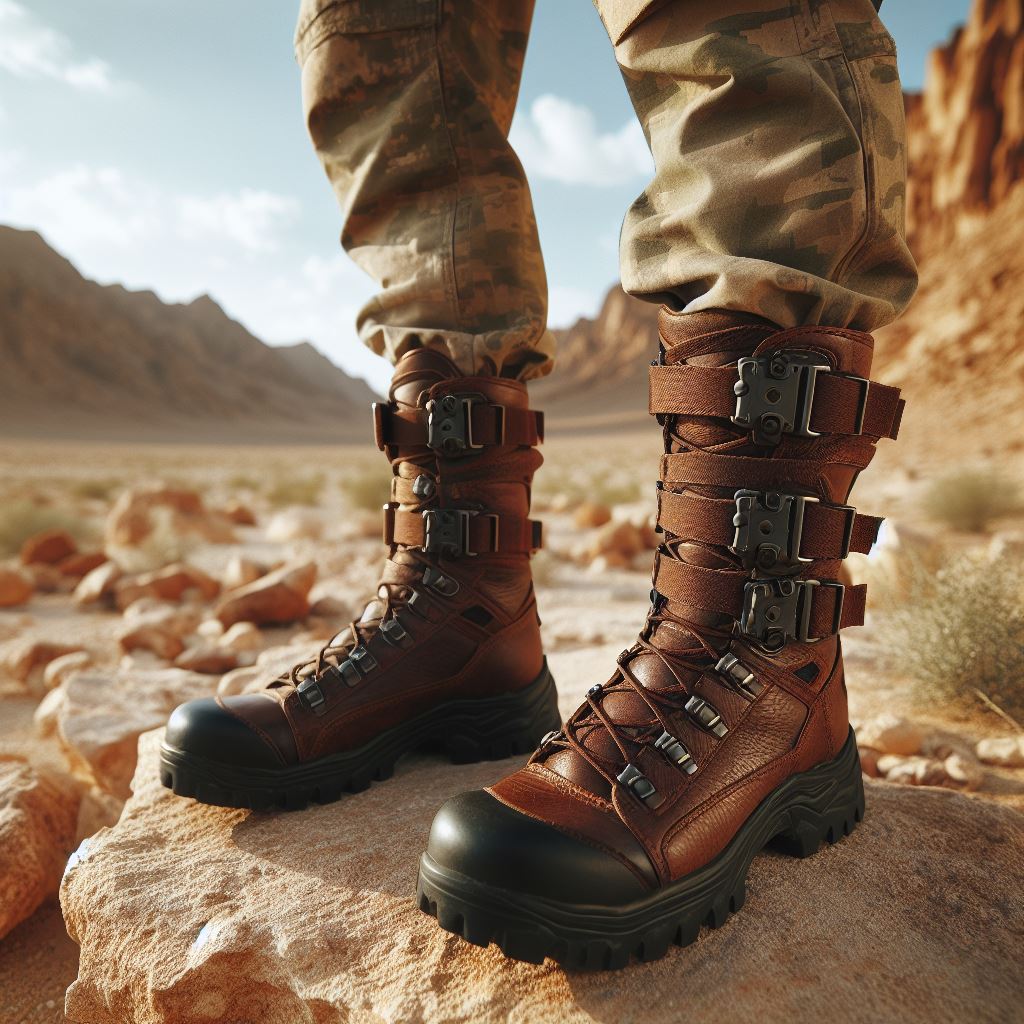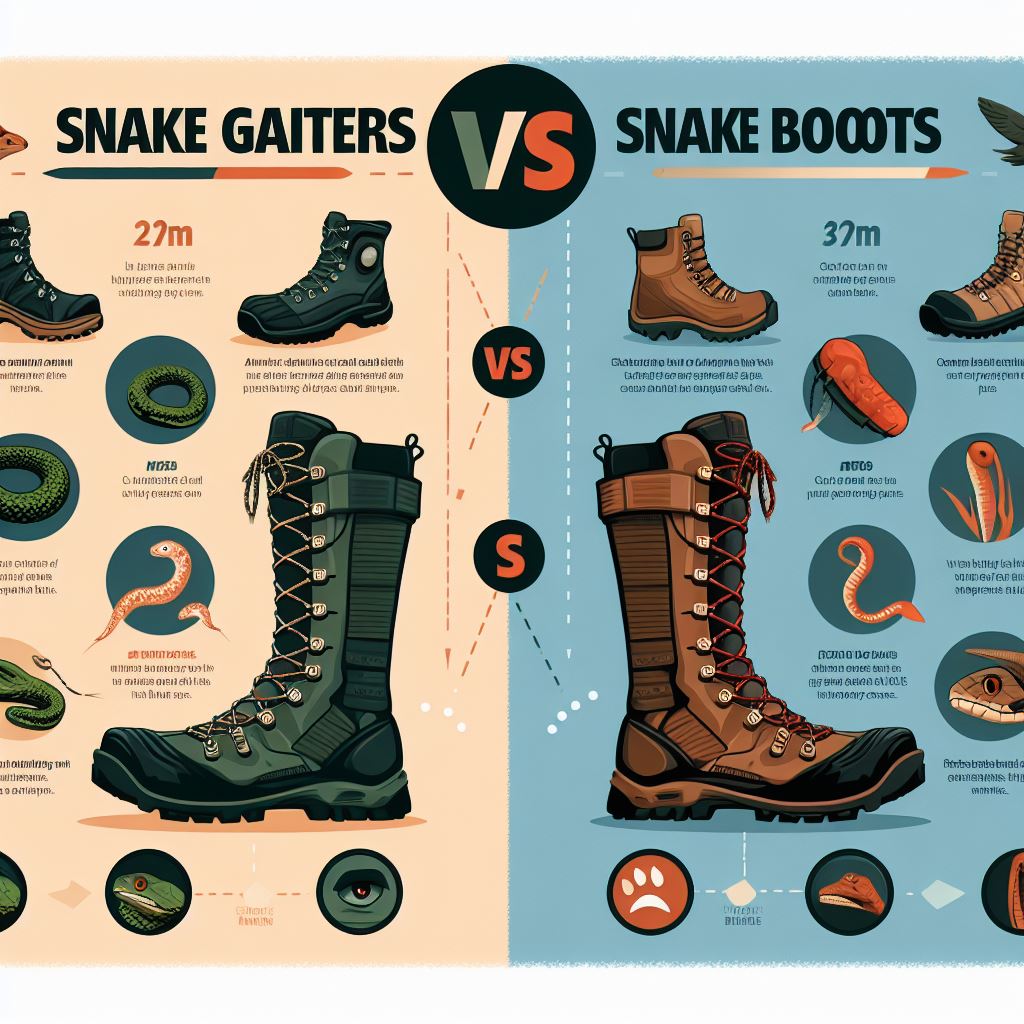When adventuring in snake territory, protecting your legs and feet from venomous bites is a must. Snake gaiters and snake boots are two popular options for hikers, hunters, and outdoor enthusiasts to prevent snakebites when traversing areas populated by rattlesnakes, copperheads, cottonmouths, and other dangerous snakes.
But how do you choose between snake gaiters and snake boots? Both can provide protection, but they have key differences in coverage area, breathability, ease of movement, weight, and more.
This guide examines the pros and cons of snake gaiters vs snake boots to help you determine which is better for your specific hiking needs and preferences.
What are Snake Gaiters?

Snake gaiters are protective coverings worn over the leg and foot to create a snake-proof barrier. They are typically made of tightly woven nylon, Kevlar, or ballistic nylon fabric.
Gaiters come up to just below the knee and use a combination of zippers, buckles, velcro, and sometimes snaps to securely close around the calf and foot. Adjustable straps at the top go under boot tops to keep them snug.
The age-old canvas gaiters used by cowboys have evolved into modern protective versions designed specifically for snakes and other environmental hazards.
Some features of snake gaiters include:
- Coverage from ankle to just below knee
- Breathable fabrics that prevent overheating
- A tight weave prevents snake fangs from penetrating
- Secure closure mechanisms to keep the gaiter tight to the leg
- Lightweight and flexible for ease of movement
- Often camouflage patterned for stealth
What are Snake Boots?

Snake boots are boots specially engineered to prevent snakebites. They use thick, protective material layers and extended boot heights to fully shield the foot and leg.
Most snake boots are made of leather or a mix of leather, nylon, and textile fabrics. The boots rise 16-20 inches tall to cover the calf and knee area. Snake proof mesh, Kevlar, and fiberglass are often used as lining to prevent fang penetration while allowing airflow.
Key features of snake boots include:
- The external material is puncture-resistant
- The inner lining prevents fangs from penetrating
- Minimum 16+ inch height for above-ankle protection
- Tight seal at calf to prevent entry points
- Sturdy bottoms provide traction
- Waterproofing for wet environments
- Camouflage options for stealth
Some snake boots are insulated and can double as cold weather hunting boots during winter outdoor excursions.
Snake Gaiters vs. Snake Boots: Comparison Table
| Attribute | Snake Gaiters | Snake Boots |
|---|---|---|
| Coverage Area | Ankle to just below knee | Foot to above knee |
| Breathability | High, fabric allows airflow | Low-moderate, less ventilation |
| Weight | Lightweight 8-15oz | Heavier 2-5lbs |
| Mobility | High, flexible fabric | Moderate, stiffer construction |
| Convenience | Easy on/off over shoes | More involved to put on/take off |
| Durability | Minimal insulation keeps cool | High, tough leather and materials |
| Cost | $$ Affordable $40-$100 | $$$ More expensive $120-$300 |
| Water Resistance | Low-moderate, fabric absorbs moisture | High, waterproof sealed leather |
| Warmth | Can be well-insulated for warmth | Ankle to just below the knee |
Below we examine each of these factors more closely.
Coverage Area
A primary difference between snake gaiters and snake boots is the area of your leg they protect.
Snake gaiters cover from your foot and ankle up to just below the knee. This leaves a small area of the knee exposed.
Snake boots protect your entire foot as well as your ankle, calf, shin, and knee thanks to their 16-20 inch height. This leaves no skin vulnerable to snakebites.
If complete coverage is your priority, snake boots are the way to go. Their taller design fully shields the lower leg. With snake gaiters, you must be vigilant to avoid any knee exposure around low brush.
Breathability
Due to their lighter woven fabric construction, snake gaiters allow for good airflow to your leg. This prevents sweaty discomfort in hot weather. Their breathability is a major plus during high-exertion activities like biking and hiking.
Snake boots sacrifice ventilation for sturdy puncture-proofing. Although they may incorporate some breathable fabrics, the heavier leather and layered design retains more heat. This can cause sweaty feet and discomfort when temperatures rise.
If you’ll be moving through hot, humid environments, snake gaiters offer better potential for cooling airflow. For colder weather, snake boots help insulate and keep you warmer.
Weight
Snake gaiters weigh 8-15 ounces since they are made of lightweight woven fabric. Their minimal construction keeps them very light.
In contrast, tough leather snake boots weigh 2-5 pounds due to their thick materials and sturdy soles. The heavier weight may become tiring over long distances.
If having minimal additional weight on your legs for mobility is key, snake gaiters are the clear winner. But some may prefer the heftier feel of snake boots for durability reassurance.
Mobility and Flexibility
The thin flexible fabric of snake gaiters allows for unrestricted movement of your ankle and knee. The stretchy material won’t hinder your stride as you walk, climb or crouch.
Conversely, the thicker materials of snake boots result in some loss of mobility. The stiff leather shaft can make flexing your ankle or knee more difficult. This can negatively impact agility.
If you want full freedom of movement for hiking technical trails, snake gaiters deliver better flexibility. Snake boots provide protection at the cost of mobility.
Convenience and Ease of Use
Snake gaiters conveniently fit over your shoes or boots, securing with straps and zippers around your calf. They easily slide on and off as needed.
Snake boots must be fully put on and taken off with each wear. Their taller shaft makes them more difficult than regular boots to pull on. Their snug fit also takes some work to remove.
For activities where you’ll be frequently removing or putting on your snake protection, gaiters allow quick on-off access. Boots take more time and effort to get in and out of.
Durability and Tear Resistance
Snake boots are the clear winner when it comes to durability. Their thick leather construction holds up well to abuse from brush, branches and gravel. With proper care, they can be worn for countless miles.
The thin fabric of snake gaiters is vulnerable to snagging, tearing or wearing thin from repeated friction. They must be carefully inspected for damage after each use. When worn out, gaiters need full replacement.
If you want long lasting footwear, quality snake boots with their rugged build are the better investment. But gaiters can also last for several seasons with proper use and storage.
Water Resistance
Snake boots keep feet dry thanks to waterproof sealed leather and tightly taped seams. Their barrier construction blocks mud and water from seeping in. This makes them ideal for wet terrain and during rains.
Snake gaiters provide minimal water protection since they absorb moisture. On rainy hikes or marshy areas, they’ll quickly get soaked and transfer wetness to your boots and socks.
If dry feet are vital for comfort, snake boots’ waterproofing has a big advantage. But in hot, humid climates too much waterproofing can cause sweaty discomfort.
Warmth and Insulation
In colder weather, snake boots offer welcome insulation. Leather retains heat and manufacturers add wool or ThinsulateTM lining for warmth, making them ideal for winter use. Some models even rate themselves for subfreezing and extreme cold.
Conversely, snake gaiters provide minimal warmth themselves. Their thin fabric maintains air flow to your skin. This thwarts overheating when active, but offers little insulation benefit for cold protection.
If warding off winter chill is a priority, snake boots with insulation deliver. But the tradeoff is reduced ventilation and moisture-wicking compared to gaiters.
Cost and Budget
Due to their involved construction and quality materials, snake boots carry a hefty price tag. Expect to spend $180-$300 or more for a durable high-end pair. More budget-friendly options can be found for $120-$150.
Snake gaiters made of fabric and minimal hardware are more affordable at $40-$100. Even high-end designs with protective Kevlar only run $70-$120.
If price is a limiting factor, snake gaiters deliver snake protection at a fraction of the cost. But viewed as a long-term investment, snake boots may justify the higher expenditure through years of use.
Here are some key situations where snake gaiters are the better choice over snake boots:
Hot Weather Hiking
For hiking in hot climates, snake gaiters allow maximum airflow and breathability to keep your legs cooler. Their lightweight design won’t burden you. Snake boots may lead to uncomfortable overheating.
Technical Terrain Navigation
The flexible fabric of gaiters won’t impede your ankle’s range of motion as you climb over rocks or logs. Their grippy tread also helps secure footing.
Frequently Entering and Exiting Protected Areas
If you’ll be moving in and out of high risk areas, gaiters slide on and off quicker for temporary protection. Taking boots on and off repeatedly is more work.
Weight Sensitive Adventures
Minimizing weight is key for backpacking, trail running, biking, etc. At 8-15oz, gaiters add negligible weight versus heavy snake boots.
Low Brush and Grasses
Gaiters protect well when stepping through knee-high brush and grasses where snakes lurk. Boots exceed the necessary height.
Water Exposure Risk is Low
If you won’t be near lakes or heavy rains, gaiters provide adequate dryness. Save pricey waterproof boots for wetter environments.
Tight Budget Constraints
When cost is a limiting factor, gaiters offer reliable snake protection at $40-$100. Boots run $180+ for comparable reliability.
When are Snake Boots the Better Choice?

Here are some scenarios where snake boots outperform gaiters:
Full Lower Leg Protection is Needed
Boots completely shield your ankle, shin, calf and knee from snakebites. Gaiters still leave a small gap at the knee.
Cold Weather Missions
Insulated snake boots provide warmth when autumn and winter temperatures drop. Breathable gaiters won’t retain much heat.
Water Immersion is Likely
Snake boots keep feet dry in marshes, heavy rain and dew thanks to waterproof leather. Regular gaiters absorb water and moisture.
Long Treks Over Miles
The sturdy support of snake boots hold up mile after mile with heavier loads. Gaiters may sag or wear out faster over long distances.
Farming and Ranch Work
Rugged snake boots withstand the scrapes and abrasions of agricultural work. Flimsy gaiters would soon rip or tear.
Maximum Ankle Support is Needed
Stiff snake boots stabilize ankles from injury on uneven ground. Flexible gaiters provide minimal support.
Long Term Use Over Multiple Seasons
Well-made boots withstand years of wear. Gaiters need replacing annually as they wear and thin.
Best Materials for Snake Gaiters
When shopping for snake gaiters, look for these protective materials:
- Ballistic Nylon – Tightly woven nylon that is highly abrasion resistant.
- Cordura Nylon – Durable thick nylon able to handle rugged use.
- Kevlar – Cut resistant para-aramid fiber material stronger than steel. Offers puncture protection.
- Snake Guard Fabric – Proprietary fabric with a Teflon coated exterior to enhance snakebite protection.
- Leather – Natural leather provides additional abrasion resistance in high wear areas.
- Reinforced Knee – Extra layers of fabric or pads at the knee for durability and protection.
- Full Length Zippers – Zippers that extend the full length make donning and doffing easier.
Avoid gaiters made only of basic nylon, polyester or cheap canvas. These offer inadequate bite protection. Seek out specialty snake gaiter materials for maximum defense.
Best Materials for Snake Boots
Look for these protective materials when selecting snake boots:
- Puncture-Resistant Snake Guard Lining – Interior lining prevents penetration of fangs. Made of flexible Teflon-coated fabric.
- Leather – Thick bullhide, cowhide or full grain leather resists abrasions, tears and punctures. Look for at least 10+ inch upper.
- Snake Proof Mesh – Woven material along calf allows ventilation while blocking fangs.
- Kevlar – Ultra strong Kevlar fibers provide cut resistance and durability.
- Fiberglass Shank – Shank embedded into sole adds rigidity to prevent bending and fang entry.
- Neoprene Lining – Neoprene provides comfort and waterproofing. Wicks away moisture.
- Removable Insoles – Cushioned insoles that can be removed to air out interior and wick away moisture.
The most protective snake boots use a combination of these bite-stopping materials to shield your legs. They should carry an ASTM high Snakebite Protection Rating.
How to Choose the Right Size
It’s important to choose the correct size for maximum protection from both gaiters and boots.
Snake Gaiters
Gaiters should fit snugly, but not restrict circulation. Measure your calf circumference to determine proper sizing. For width, stand with weight evenly distributed to find your comfortable foot width. Avoid going too loose or tight.
Snake Boots
Try boots on while wearing typical socks you’ll hike in. Aim for a secure fit with minimal heel lift when walking. Too loose and fangs can penetrate. Too tight restricts blood flow. Break in new boots gradually.
Consider comfort, intended conditions and protective ability when selecting snake gaiter or boot sizing. Proper fit ensures defenses stay intact during activity.
How to Wear Snake Gaiters and Boots
Follow these tips to properly wear your snake gaiters or boots for maximum protection:
Snake Gaiters
- Pull gaiters on over shoes or boot tops, ensuring no gaps.
- Secure all buckles, straps and zippers fully.
- Check for snugness around calf and ankle as you walk.
- Ensure gaiter bottoms drape over shoe tops with no skin showing.
- Pull pants over gaiter tops to close any gaps at the knee.
- Inspect for rips, holes or worn fabric after each use.
Snake Boots
- Loosen laces fully and unzip to pull on. Re-tighten gradually.
- Ensure pant legs are outside of boots, not tucked in.
- Zip boots up fully ensuring no gaps at calf.
- Break in new boots to soften leather and improve flexibility.
- Use sealant to close any tiny fang entry points you discover.
- Check soles for damage from rough terrain after each wear.
Properly worn snake protection gear shields vulnerable areas and deters venomous bites. Take time onsite to double check for secure closure and coverage.
How to Clean and Maintain Snake Gaiters and Boots
Follow these tips to keep your snake protection performing well for years:
Snake Gaiters
- Spot clean fabric as needed with a damp cloth and mild detergent. Line dry only.
- Periodically treat fabric with seam sealant sprays for added waterproofing.
- Store flat and loosely rolled, not crumpled.
- Disinfect with boiling water or diluted bleach if exposed to snakes.
Snake Boots
- Remove insoles and air boots out fully after each use.
- Wash away dirt with saddle soap, wipe excess foam away.
- Use leather conditioner regularly to prevent cracking.
- Store with shoe trees inserted to absorb moisture and maintain shape.
- Disinfect with quaternary ammonium spray if exposed to snakes.
- Apply sealants and glue to close any newfound gaps in protection.
Proper cleaning and storage keeps boots and gaiters in top shape for years of continued performance protecting you from snakebites.
Key Takeaways on Snake Gaiters vs. Snake Boots
- Snake gaiters offer lightweight, breathable protection from the ankle to just below knee. Great for hot weather and mobility. More affordable price.
- Snake boots fully shield from foot to above knee. Excellent durability and waterproofing. Better for cold weather and extensive use.
- Gaiter advantages include cooling ventilation, ease of movement and convenience on/off. Great for temporary protection needs.
- Boot advantages include total coverage, ankle support, and long-term reliability. Better for extensive exposure to snakes.
- Match choice to your specific needs and conditions. Gaiters meet many hikers’ summer needs while boots excel for cold winter use.
- Look for robust snake-proof materials like Kevlar and Snake Guard fabric in quality gaiters and boots.
Get the right level of protection you require while optimizing for seasonal conditions, exposure time, mobility needs and budget constraints. With proper use and maintenance, quality snake gaiters and boots defend against venomous trouble on the trails for years of adventure.

More Stories
The Ultimate Guide to Anteater Boots in 2024
Snake Boots vs Chaps: Which Offers Better Protection?
Magellan Snake Boots Review 2024: Effective Protection from Venomous Bites